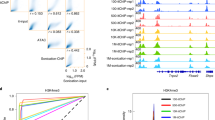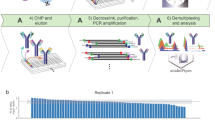Abstract
Epigenetic mechanisms such as histone modifications play critical roles in adaptive tuning of chromatin structures. Profiling of various histone modifications at the genome scale using tissues from animal and human samples is an important step for functional studies of epigenomes and epigenomics-based precision medicine. Because the profile of a histone mark is highly specific to a cell type, cell isolation from tissues is often necessary to generate a homogeneous cell population, and such operations tend to yield a low number of cells. In addition, high-throughput processing is often desirable because of the multiplexity of histone marks of interest and the large quantity of samples in a hospital setting. In this protocol, we provide detailed instructions for device fabrication, setup, and operation of microfluidic oscillatory washing–based chromatin immunoprecipitation followed by sequencing (MOWChIP-seq) for profiling of histone modifications using as few as 100 cells per assay with a throughput as high as eight assays in one run. MOWChIP-seq operation involves flowing of chromatin fragments through a packed bed of antibody-coated beads, followed by vigorous microfluidic oscillatory washing. Our process is semi-automated to reduce labor and improve reproducibility. Using one eight-unit device, it takes 2 d to produce eight sequencing libraries from chromatin samples. The technology is scalable. We used the protocol to study a number of histone modifications in various types of mouse and human tissues. The protocol can be conducted by a user who is familiar with molecular biology procedures and has basic engineering skills.
This is a preview of subscription content, access via your institution
Access options
Access Nature and 54 other Nature Portfolio journals
Get Nature+, our best-value online-access subscription
$29.99 / 30 days
cancel any time
Subscribe to this journal
Receive 12 print issues and online access
$259.00 per year
only $21.58 per issue
Buy this article
- Purchase on Springer Link
- Instant access to full article PDF
Prices may be subject to local taxes which are calculated during checkout








Similar content being viewed by others
Code availability
A custom script is included as Supplementary Data 4.
References
Egger, G., Liang, G. N., Aparicio, A. & Jones, P. A. Epigenetics in human disease and prospects for epigenetic therapy. Nature 429, 457–463 (2004).
Campos, E. I. & Reinberg, D. Histones: annotating chromatin. Annu. Rev. Genet. 43, 559–599 (2009).
Strahl, B. D. & Allis, C. D. The language of covalent histone modifications. Nature 403, 41–45 (2000).
Zhou, V. W., Goren, A. & Bernstein, B. E. Charting histone modifications and the functional organization of mammalian genomes. Nat. Rev. Genet. 12, 7–18 (2011).
Zhao, Y. & Garcia, B. A. Comprehensive catalog of currently documented histone modifications. Cold Spring Harb. Perspect. Biol. 7, a025064 (2015).
Barski, A. et al. High-resolution profiling of histone methylations in the human genome. Cell 129, 823–837 (2007).
Wang, Z. et al. Combinatorial patterns of histone acetylations and methylations in the human genome. Nat. Genet. 40, 897–903 (2008).
Cao, Z., Chen, C., He, B., Tan, K. & Lu, C. A microfluidic device for epigenomic profiling using 100 cells. Nat. Methods 12, 959–962 (2015).
Adli, M., Zhu, J. & Bernstein, B. E. Genome-wide chromatin maps derived from limited numbers of hematopoietic progenitors. Nat. Methods 7, 615–618 (2010).
Shankaranarayanan, P. et al. Single-tube linear DNA amplification (LinDA) for robust ChIP-seq. Nat. Methods 8, 565–567 (2011).
Lara-Astiaso, D. et al. Immunogenetics. Chromatin state dynamics during blood formation. Science 345, 943–949 (2014).
Ma, S., Hsieh, Y.-P., Ma, J. & Lu, C. Low-input and multiplexed microfluidic assay reveals epigenomic variation across cerebellum and prefrontal cortex. Sci. Adv. 4, eaar8187 (2018).
Rotem, A. et al. Single-cell ChIP-seq reveals cell subpopulations defined by chromatin state. Nat. Biotechnol. 33, 1165–1172 (2015).
Skene, P. J. & Henikoff, S. An efficient targeted nuclease strategy for high-resolution mapping of DNA binding sites. Elife 6, e21856 (2017).
Skene, P. J., Henikoff, J. G. & Henikoff, S. Targeted in situ genome-wide profiling with high efficiency for low cell numbers. Nat. Protoc. 13, 1006–1019 (2018).
Hainer, S. J., Boskovic, A., McCannell, K. N., Rando, O. J. & Fazzio, T. G. Profiling of pluripotency factors in single cells and early embryos. Cell 177, 1319–1329 (2019).
Kaya-Okur, H. S. et al. CUT&Tag for efficient epigenomic profiling of small samples and single cells. Nat. Commun. 10, 1930 (2019).
Harada, A. et al. A chromatin integration labelling method enables epigenomic profiling with lower input. Nat. Cell Biol. 21, 287–296 (2019).
Consortium, E. P. et al. An integrated encyclopedia of DNA elements in the human genome. Nature 489, 57–74 (2012).
Roadmap Epigenomics Consortium. et al. Integrative analysis of 111 reference human epigenomes. Nature 518, (317–330 (2015).
Brower, K. et al. An open-source, programmable pneumatic setup for operation and automated control of single- and multi-layer microfluidic devices. HardwareX 3, 117–134 (2018).
Thorsen, T., Maerkl, S. J. & Quake, S. R. Microfluidic large-scale integration. Science 298, 580–584 (2002).
Unger, M. A., Chou, H.-P., Thorsen, T., Scherer, A. & Quake, S. R. Monolithic microfabricated valves and pumps by multilayer soft lithography. Science 288, 113–116 (2000).
Brower, K., White, A. K. & Fordyce, P. M. Multi-step variable height photolithography for valved multilayer microfluidic devices. J. Vis. Exp. 2017, 55276 (2017).
Ma, S. et al. Cell-type-specific brain methylomes profiled via ultralow-input microfluidics. Nat. Biomed. Eng. 2, 183–194 (2018).
Horz, W. & Altenburger, W. Sequence specific cleavage of DNA by micrococcal nuclease. Nucleic Acids Res. 9, 2643–2658 (1981).
Dingwall, C., Lomonossoff, G. P. & Laskey, R. A. High sequence specificity of micrococcal nuclease. Nucleic Acids Res. 9, 2659–2673 (1981).
Jung, Y. L. et al. Impact of sequencing depth in ChIP-seq experiments. Nucleic Acids Res. 42, e74 (2014).
Langmead, B., Trapnell, C., Pop, M. & Salzberg, S. L. Ultrafast and memory-efficient alignment of short DNA sequences to the human genome. Genome Biol. 10, R25 (2009).
Li, H. et al. The sequence alignment/map format and SAMtools. Bioinformatics 25, 2078–2079 (2009).
Quinlan, A. R. & Hall, I. M. BEDTools: a flexible suite of utilities for comparing genomic features. Bioinformatics 26, 841–842 (2010).
Zhang, Y. et al. Model-based analysis of ChIP-Seq (MACS). Genome Biol. 9, R137–R137 (2008).
Xu, S., Grullon, S., Ge, K. & Peng, W. Spatial clustering for identification of ChIP-enriched regions (SICER) to map regions of histone methylation patterns in embryonic stem cells. Methods Mol. Biol. 1150, 97–111 (2014).
Thorvaldsdóttir, H., Robinson, J. T. & Mesirov, J. P. Integrative genomics viewer (IGV): high-performance genomics data visualization and exploration. Brief. Bioinform. 14, 178–192 (2013).
Robinson, J. T. et al. Integrative genomics viewer. Nat. Biotechnol. 29, 24–26 (2011).
Cox, M. C., Deng, C., Naler, L., Lu, C. & Verbridge, S. S. Effects of culture condition on epigenomic profiles of brain tumor cells. ACS Biomater. Sci. Eng. 5, 1544–1552 (2019).
Acknowledgements
We thank J. González-Maeso of Virginia Commonwealth University for providing mouse brain samples. This work was supported by US National Institutes of Health grants CA214176 (C.L.), EB017235 (C.L.), HG009256 (C.L.) and HG008623 (C.L.) and seed grants from the Center for Engineered Health of the Virginia Tech Institute for Critical Technology and Applied Science.
Author information
Authors and Affiliations
Contributions
C.L. conceived the concept of MOWChIP-seq and supervised the research and development. Y.-P.H. and B.Z. conducted MOWChIP-seq assays with various samples. T.W.M. set up the control system for multi-unit MOWChIP devices. Q.Z. helped optimize the protocol. L.B.N. wrote the script for data analysis. B.Z., T.W.M., L.B.N. and C.L. wrote the manuscript. All authors commented on the manuscript.
Corresponding author
Ethics declarations
Competing interests
C.L. declares that he is a co-inventor of a US patent (9,732,377) issued on MOWChIP-seq. The remaining authors declare no competing interests.
Additional information
Peer review information Nature Protocols thanks Jeong Heon Lee and other anonymous reviewer(s) for their contribution to the peer review of this work.
Publisher’s note Springer Nature remains neutral with regard to jurisdictional claims in published maps and institutional affiliations.
Related links
Key references using this protocol
Cao, Z., Chen, C., He, B., Tan, K. & Lu, C. Nat. Methods 12, 959–962 (2015) https://doi.org/10.1038/nmeth.3488
Cox, M., Deng, C., Naler, L. B., Lu, C. & Verbridge, S. S. ACS Biomater. Sci. Eng. 5, 1544–1552 (2019) https://doi.org/10.1021/acsbiomaterials.9b00161
Integrated supplementary information
Supplementary Fig. 1 Various tubing assemblies used in the protocol.
(a) The tubing assemblies. (b) The assemblies connected to a microfluidic device.
Supplementary information
Supplementary Information
Supplementary Fig. 1
Supplementary Data 1
A LabVIEW program for operating the single-unit MOWChIP device.
Supplementary Data 2
A LabVIEW program for operating the eight-unit MOWChIP device.
Supplementary Data 3
A LayoutEditor file for the eight-unit MOWChIP device.
Supplementary Data 4
A custom script for ChIP-seq data analysis.
Supplementary Video 1
A video on major steps involved in MOWChIP.
Rights and permissions
About this article
Cite this article
Zhu, B., Hsieh, YP., Murphy, T.W. et al. MOWChIP-seq for low-input and multiplexed profiling of genome-wide histone modifications. Nat Protoc 14, 3366–3394 (2019). https://doi.org/10.1038/s41596-019-0223-x
Received:
Accepted:
Published:
Issue Date:
DOI: https://doi.org/10.1038/s41596-019-0223-x
This article is cited by
-
Droplet-based bisulfite sequencing for high-throughput profiling of single-cell DNA methylomes
Nature Communications (2023)
-
Epigenomic and transcriptomic analyses reveal differences between low-grade inflammation and severe exhaustion in LPS-challenged murine monocytes
Communications Biology (2022)
-
Joint single-cell multiomic analysis in Wnt3a induced asymmetric stem cell division
Nature Communications (2021)
-
Chromatin integration labeling for mapping DNA-binding proteins and modifications with low input
Nature Protocols (2020)
Comments
By submitting a comment you agree to abide by our Terms and Community Guidelines. If you find something abusive or that does not comply with our terms or guidelines please flag it as inappropriate.



